-
WÙLU (Dauda Coulibaly 2016)
DAOUDA COULIBALY: WÙLU (2106)
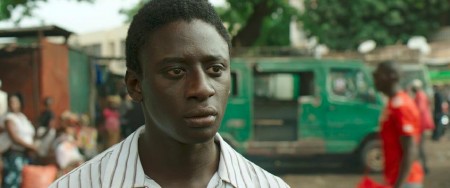
IBRAHIM KOMA IN WÙLU
A dangerous success
Wùlu, Ladji, a young Malian who's continually on the screen, switches from bus driving to drug trafficking and earns himself and his sister a lot of money. They rise to the top of Bamako society and Ladji gets into more and more danger - right to the edge of doom. A posT-film title explains that the cocaine boom in Mali brought vast sums into the country, and that was a large factor in the political crisis of the past five years. So, a thriller that is topical and political, confident and brightly colored and full of energy from first to last. This is an unusually accomplished and great-looking first film from Africa whose mise-en-scène, from hovels to mansions, town squares to desert shootouts, is impeccable.
As Ladji, Ibrahim Koma (who was actually born in Paris) is impressive, confident too, a dark, burnished statue who rarely shows fear or uncertainty. He is continually on the screen and we are asked to care about him, but so great is his impassivity and remoteness it may be a bit hard to care about him. We understand his logic and his motives. He's driven cross-country busses for five years and we see him at first explaining to a novice who to let on board. No fatties: they take up too much space. No sexy women: too distracting. No old people: too slow. He's got it aced, but when a nephew of the boss takes over his driving job and, absent the expected promotion he angrily walks off the job and to Driss, a drug dealer who owed him a favor and presto! he's transporting pot the Senegal on busses and bringing back cocaine. He innovates, suggesting small passenger vans, which customs passes because they'r too much trouble to check. Except there's a dangerous contretemps the very first run, and when he gets back, Driss is murdered.
From then on it's success following success and as the ante increases, just like Scarface, the hero flies closer to the sun. Ladji and his two pals and cohorts Houphouet (Jean-Marie Traoré) and Zol (Ismaël N’Diaye) start working for Driss's boss, Jean-François (Olivier Rabourdin). So much money is coming in, they're sent further afield, to Timbuktu, with weapons. And they need them.
Intermixed with the intense, accelerating narrative of the drug trafficking, which gets more dangerous and more profitable all the time, is the story of himself and his sister Aminata, a prostitute when we meet her, later a professional party girl (played by Malian singer Inna Modja). Ladji has so much money he buys land and builds a big house with a large pool. He's not happy - the danger of his criminal operations is matched by financial risks, and realization that his liaison with the high class Assitan (Mariame N’Diaye), which Aminata first pointed him to, is shaky, because he not respectable - and the high living has put him in heavy debt, which hits the fan when political disintegration in a neighboring country forces his French drug boss to check out and banish him. Again he goes higher, to Assitan's father, for more risk and more profit. Again Coulibaly has surprises in store for us.
Wùlu is well-written and skillfully plotted. It has constant excitement. Its scenes or social excess are as colorful as those of crime. It merely suffers from that familiar problem of actioners. It never stops for breath. The non-stop intensity holds our attention. But it also makes every moment equally tense, thus reducing some of the force of climactic moments - and leaving little room to set mood or develop character. There is nothing wrong with making Ladji a kind of Camus Stranger, an empty man, although this story hasn't the style of a movie by Jean-Pierre Melville or the philosophical underpinnings of Camus. But it's damn good stuff for an African debut film, it looks great, and its cast is excellent.
Wùlu, 95 mins. (in Bambara and French), debuted at Angoulême Aug. 2016; in at least nine other international festivals including Toronto, Hamburg, London, Gothenburg and the Film Society of Lincoln Center-Museum of Modern Art New Directors/New Films festival, as part of which it was screened for this review. See the highly favorable reviews from Toronto by Pamela Pianezza in Variety and Boyd van Hoeij in Hollywood Reporter.
New Directors showtimes:
Saturday, March 18 1:30 pm MoMA
Sunday, March 19 6:45 pm Walter Reade Theater FSLC
Last edited by Chris Knipp; 03-01-2017 at 05:00 AM.
-
ARÁBIA (João Dumans, Affonso Uchoa 2017)
JOÃO DUMANS, AFFONSO UCOA: ARÁBIA (2017)
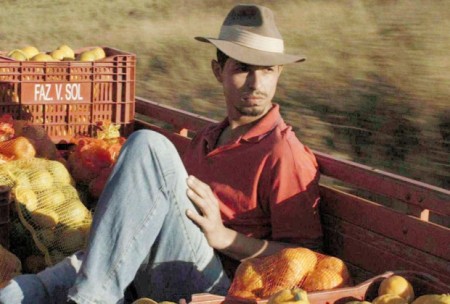
ARISTIDES DE SOUSA IN ARÁBIA
The wanderer
Arábia is storytelling. It's about a wanderer, who worked at all kinds of laborer jobs imaginable in Brazil. So it's also about labor, pretty explicitly. Neil Young in Hollywood Reporter called it a "political road movie." But it's not so much a tract (or a "road movie") as a meditation about loneliness and rootlessness, while at the same time full of manly togetherness and music - a lot of music, which helps mitigate the sadness. This is a unique thinking man's film, rather like a novel - though its interest isn't so much in the content as in the meditative structure and the moody atmosphere. For some reason - the philosophical voiceover, partly - it reminded me of Wong Kar Wai's Happy Together.
Arábia takes its time getting started, in the manner of old-fashioned adventure tales. It's a full 20 minutes before the title even appears. First there isa long shot (arguably longer than necessary), of a youth, Andre (Murilo Caliari), riding a bike, then a song, and up to the title it looks like this movie is going to be about Andre. Then news that a man named Cristiano (Aristides de Sousa), who lived nearby in this industrial neighborhood in Ouro Preto, Brazil in the southern state of Minas Gerais, near an old aluminum factory, where he, Cristiano, worked, has been in an accident and is in the hospital. Andre is sent to Cristiano's flat to get clothes for him and his ID. When there, Andre comes across a notebook with a journal in it. Writing about "important events in his life" turns out to have been a project of a factory theater group, which Cristiano joined to be more among people. Well, Andre begins to read the journal. . .
And what follows in the rest of Arábia is a narrative - the journal - in De Sousa's voice of Cristiano's many wanderings, in his voice over the past decade, all over the country working at all kinds of jobs, a one-man tour of the world of physical labor. We see him as the story unfolds in many diverse scenes. The filmmakers make no secret of their focus on the subject of manual labor. One memorable scene has Cristiano discussing with a companion of the time - people come and go in his life, including his one true love Ana (Renata Cabral)- a an older man who is shortly to die of diabetes - what contents are best and worst to load onto a truck: cement, tile, potatoes, etc. And at the final factory he starts working the night shift and explains why it's bad.
But Aristedes deSousa, with his strong, rough voice and lean features, is never a metaphor, always real, and so are the situations and settings. This is also a story of hard knocks. Cristiano does jail time, and another thing happens that could have led to jail. The story with Ana is suffused with sadness. And loss of best friends, when circumstances force a sudden departure. And constant change of venue every few months or year or so. There is a sense of sampling, of exploration, and one may think of Orwell's Down and Out in Paris and London.
It is the combination of its contemplation and filtering of experience along with, through images, the retaining of the experience in very specific and vivid form that gives this film its special quality. Through the film we live life and examine it at the same time, and this is what is novelistic and not like most films.
Arábia, 97 mins, debuted at Rotterdam 1 Feb. 2017. It was screened for this review as part of New Directors/New Films (Film Society of Lincoln Center, MoMA).
Showtimes:
SATURDAY, MARCH 18 4 p.m. Walter Reade Theater FSLC
SUNDAY, MARCH 19 6:30 p.m. MoMA
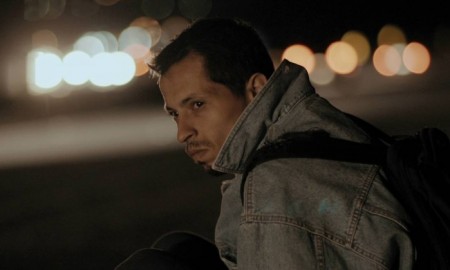
ARISTIDES DE SOUSA IN ARÁBIA
Last edited by Chris Knipp; 03-01-2017 at 06:20 PM.
-
BY THE TIME IT GTS DARK/DAO KHANONG (Anocha Suwichakornpong 2016)
ANOCHA SUWICHAKORNPONG: BY HE TIME IT GETS DARK/DAO KHANONG (2016)
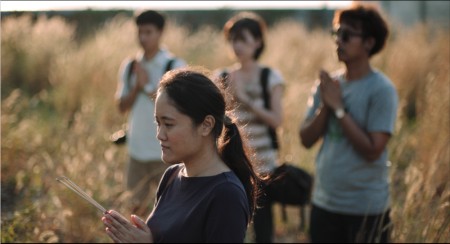
A cinematic experiment of great elegance, all in the head
Anocha Suwichakornpong is a made-to-order film festival darling. Her films are exquisite, hushed, and conceptually complex. Their visual debt to her more famous countryman "Joe" Apichatpong Weerasethakul is obvious. The point of departure of By the Time It Gets Dark, is a film, or film within a film, related to the 1976 massacre of Thai student dissidents at a university. The settings are beautiful - perhaps too beautiful: this seems like a brochure for a decoration magazine. The people are too beautiful too, including the young men whose regular features - and, at one point, smooth naked thighs - are lovingly dwelt upon. When anything serious happens, like the death of a leading cast member in a car accident, it goes by with such a tiny scintilla of emotion that you don't wonder that the massacre doesn't build up much heat either.
A brace of art-film critics, excerpted by Critics Roundup, have penned enthusiastic comments on the film. Jay Kuehner (from Toronto, Sept. 2016), for instance: "To call what happens in By the Time It Gets Dark a 'plot' is to do it a disservice of sorts, such is the beguilingly self-reflexive nature of Anocha Suwichakornpong’s becalmed, trippy, historically conscious fungus of a film." Which is to say it vanishes up its own arse, seduced by its own cleverness and elegance. Perhaps it is "deeply felt," as a festival blurb claims. Certainly a massacre, with thousands injured and at least 50 to 100 killed by royalists and right wing troops, is something to do more than merely ponder but also to be angry and disturbed about.
Suwichakornpong presents protagonists who regularly change identities and scenes that play through twice in different ways with different actors. Such gestures resemble Rivette's methods in Last Year at Marienbad - except that film was clearly enigmatic and made no claim to be about an historical event. Even the favorable Film Comment comment by Jonathan Romney acknowledges that this film is in an "incongruously lyrical style, given the theme of state violence." That is the basic problem. The other is that what happens on the screen, while beautiful, is becalmed, and ultimately unengaging, except as an exercise in style and self-reflexive cinematic experimentalism. Experimentalism can be gutsy. This version is cool and weightless. Like the visitors to immaculate apartments repeatedly shown removing their shoes, this film handles everything with kid gloves, and never gets its feet wet or engages our emotions. I was not in the mood for it, and the use of a massacre as the starting point for a cinematic art piece offended me in such a way that I don't think I ever would be.
By the Time It Gets Dark/dao khanong, 105 mins., debuted at Locarno, followed by over a dozen festivals including Toronto, London, and Rotterdam. Screened for this review as part of the FSLC-MoMA series New Directors/New Films of March 2017.
Last edited by Chris Knipp; 03-01-2017 at 07:41 PM.
-
MY HAPPY FAMILY/CHEM BEDNIERI OJAKHI (Naa Ekvtimiishvili, Simon Gross 2017)
NANA EKVTIMISHVILI, SIMON GROSS: MY HAPPY FAMILY/CHEMI BEDNIERI OJAKNI (2017)
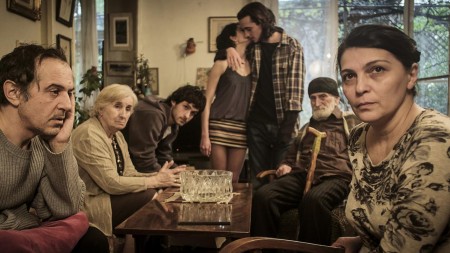
MERAB NINIDZE, BERTA KHAPAVA (LEFT), IA SHUGLIASHVILI (RIGHT) IN MY HAPPY FAMILY
Going non-traditional
One can understand why there are two directors of Ekvtimishvili and Gross's My Happy Fmily. There's a lot of complicated people-wrangling going on here. First of all in the family of Manana, a middle-aged schoolteacher (singer and stage actress Ia Shugliashvili), who do a lot of vociferous squabbling in the crowded, noisy Tbilisi flat all seven of them inhabit. It's fun to watch - until maybe it isn't any more. This is rather like a play, at first anyway. It also "opens up," and most impressive perhaps is Manana's encounter with an old school friend in a local market, the way people keep pushing through them and by them and crowding around them. It's a fine bit of choreography. If New Directors/New Films had an Ensemble Acting prize, My Happy Family would be a prime contender. (This wrangling reminded me of Asghar Farhadi's in The Salesman.)
The second reason why it's good two people directed this film: they're a couple, and this is basically a story about couples - Manana and Soso (Merab Ninidze), their daughter an her husband, and their son and the young pregnant bride he surprises everybody with later on.
Manana and Soso live with her family, which she's sick of (and we can see why). They consist of her querulous and bossy mother (Berta Khapava), her brother, her grandfather, her husband, son Lasha (Giorgi Tabidze) and daughter Nino (Tsisia Qumsashvili) and daughter's husband, augmented on occasion by aunts, uncles and other relatives, as needed. The big squabbles concern Manana's decision to move into a cheap apartment on her own, leaving her husband and all the rest, but the squabbles themselves show us why Manana would want to take this liberating step. It's not that she can't get along with her husband. She can't breathe.
Her departure is against the wishes of everyone over 25. But it's a foregone conclusion we're aware of from the first scene, when she views a sunny if shabby flat in an unfashionable but quiet neighborhood. The price is right, and the decision is made. The objections confirm its validity. But will Manana stay with this decision? Will the tomatoes she plants on the balcony bear fruit? Stay tuned - though the film ends with a question mark, as it should. The conflicts here depicted between traditional and nuclear families, couples and independence, aren't easily resolved.
This is Georgia, where the language has a special lilt, and where any festive gathering means people will sing, in a rich, resonant chorus. The most interesting chapter comes when Manana meets that old friend in the market, who's got her own farm and sells cheese. She tells about a reunion of their school, 35 years out. At this reunion Manana gets some surprise news that deeply upsets her. Though she's in a state, she's prevailed upon to sing for everyone. It's beautiful, and it relates so well to the news she's just gotten this begins to seem a little like a musical. The long takes with ensemble squabbling, the ensemble singing, the surprises, the boisterous well-wrangled small crowds: these are the charms of My Happy Family. The new apartment is nicely conveyed, with sunlight, open doors onto the balcony, Manana sitting quietly (or cleaning up the mess) and listening to Mozart. Scenes of Manana at school are few, but help flesh things out: one session with a girl who's missed classes, and turns out to have left her young husband, is an obvious parallel and link to Manana's departure. All these are aspects of this film's good staging and construction.
Its defects? None really, except that the ending is a little underwhelming (as Jordan Minzer said in his Hollywood Reporter review), and that it is a little too long. After a while it feels like this is, or ought to have been, a miniseries; or, that to be a well made film it needed better editing. It is best in its individual scenes, but some of the less necessary ones could have been shortened or cut out.
My Happy Family/Chemi bednieri ojakhi, 120 mins., debuted at Sundance Jan. 2017, then played at the Berlinale. It was screened for this review as part of the Film Society of Lincoln Center-Museum of Modern Art series, New Directors/New Films 1 Mar. 2017. Released 10 May 2017 in France as Une famille heureuse to excellent reviews - AlloCiné critic rating 3.6. English language reviews are raves - Metacritic rating 86%.
Last edited by Chris Knipp; 08-30-2017 at 06:24 PM.
-
STRONG ISLAND (Yance Fort 2017)
YANCE FORD: STRONG ISLAND (2017)
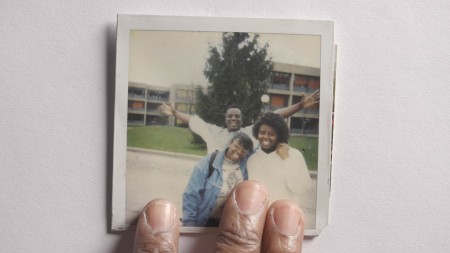
A searingly intense and complex film about a brother's killing and a family's pain
Strong Island is a documentary not of the kind that cooly informs us but of the autobiographical and otherwise intensely personal kind. A somewhat incongruous comparison might be with Nathaniel Kahn's My Architect, his exploration of his famous father, Louis Kahn. Yance Ford is exploring his family, and a single event that changed, perhaps destroyed it: the murder of his brother William a quarter century ago, when he was 23 and Yance was 18 and a sophomore at Hamilton College, by a 19-year-old white man, a mechanic in a Long Island body and "chop" (illegal spare parts) shop whose vehicle William had crashed into some time before. The events that followed are an example of racism in America and the difficulty and danger of being African American. This is a searing, powerful film.
This is also the story not just of a murder that went unpunished by a white grand jury that brought no charge but of a family, and of being gay, or being black, and how these things intertwine. Yance, one of two sisters who has since become a transgender male, is exploring his own identity. He goes through many snapshots that record the early lives of his parents - handsome, promising, and happy people, and of himself, his sister, and his brother (who never learned that he was gay). The most powerful speaker is their mother, Barbara, a teacher who became a principal and then started her own school for young women at Riker's Island, where his brother William eventually taught for a while. This experience he thinks altered William's sunny nature in the realization that there were others like him who were not yet free, still slaves.
His mother did not survive for the release of the film. His father had a stroke after William's death and not long later died. This was a peaceful black family unfamiliar with jail sentences and violence and this tragedy was devastating.
Interviews with close friends of William, including the one who was with him when he died, suggest that William drank and went to strip clubs and perused Playboy but he never got into real trouble. He was a gentle giant, a large and slightly overweight young man whose last project, detailed in his journal, which Yance shows and reads from, was to lose enough weight to qualify to train to become a corrections officer. He failed, but appealed the decision, and an irony of this scrupulously detailed film is that saved documents show six weeks after his death his appeal was granted and he was reclassified as qualified - too late.
The three Ford siblings' parents, who met in high school (but Barbara was aware of and in love with William Sr. long before), came from the Jim Crow South and lived in Brooklyn, among elderly Jewish women, which Barbara loved. She was disappointed when they moved to a nice, pleasant and inexpensive house in Long Island because it was in a black part of Long Island that was in effect a ghetto, but it pleased William Sr. to escape New York City because in his work as a train driver he saw the ugliest parts of it and wanted to get out.
There are many other ironies in this rich account. William might have been a fine correctional officer. We hear about an ADD (Assistant District Attorney) who was robbed and shot at an ATM; William chased the killer and brought him down. The ADD was gravely wounded, but was saved. The Brooklyn Bridge was shut down so he could be rushed to emergency care. When William was shot, police and hospital negligence due to his race insured that he was not saved.
At William's funeral Barbara felt convinced that William's killer would be punished, but she was to be powerfully disabused of this notion. Her appearance at the grand jury, where some of the all white group were reading magazines and ignoring her testimony, convinced her otherwise and she concludes, on camera, that her teaching of her children to be race-neutral in judgment was wrong. By implication, they ought to have been taught that the white man is the enemy. It seems also that William made a grievous error to begin with with Mark Reilly. He hit Reilly's car. Reilly said that if he would not report the accident he would repair William's car for free. He should have had nothing to do with Reilly and realized that he was on dangerous ground with him from the start.
Another irony of the film is that while it may seem to viewers that Yance Ford is setting out to show his brother's innocence this is not what happens. His brother secretly told him how he had menaced Mark Reilly, the mechanic, with a car door and a vacuum cleaner, and Yance should have told him he was being stupid but instead rejoiced that he was being a bad-ass. Yance counts himself as therefore sharing in the guilt of William's death. The implication is that, as a police investigator reveals to Yance, evidence shows William was sufficiently provocative and threatening to suggest, to the white grand jury at least, that Mark Reilly may have been in danger, even if shooing William was not necessary. Nevertheless that William and his friend became the principal suspects in William's death was a typical absurdity of an unjust, racially biased system.
,Strong Island, 107 mins., debuted at Sundance and has been in other festivals including the Berlinale, True/False, and New Directors/New Films, and it was as part of the latter that it was screened for this review.
Last edited by Chris Knipp; 03-01-2017 at 09:22 PM.
-
BONHEUR ACADÉMIE/HAPPINESS ACADEMY (Kaori Kinoshita & Alain Della Negra 2017)
KAORI KIINOSHITA, ALAIN DELLA NEGRA: BONHEUR ACADÉMIE/HAPPINESS ACADEMY (2017)
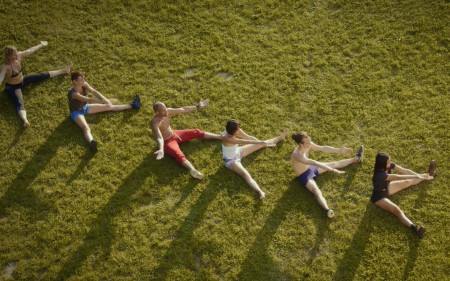
A superficial picture of New Age togetherness
The trouble with Bonheur Académie/Happiness Academy, a docudrama about a Raëlian summer gathering at a hotel complex in Croatia, is how superficial it is. And because it's sort of faked, we only get to "know" a handful of "participants" who are cast members: the movie doesn't look in on a wide spectrum except where they introduce themselves on mike at an early gathering.
And what do they all do? Listen to Raël, Claude Vorilhon, the white-bearded, Geneva-based 70-year-old cult leader, the "man in white," talking from a remote hookup on two big flat screens to the gathered participants. This gentleman, who likes laughing and happiness and has been at this for over 40 years, allegedly talked to outer space creatures who set up planet earth. But there is only passing reference to these beliefs. Most of what we see are rituals you might find in various New Age-y gatherings, people playing get-together games, talking about themselves in a New Age-y way, declaring their love of each other, stripping and touching, humming, singing, dancing and swimming, having a supervised good time if you like this kind of feel-good summer camp. It's sort of like a commune without the hard work and poverty.
A peculiarity of Raëlianism is it favors sex. There are several unusual wrinkles. Participants are encouraged to wear one of a whole line of colored wrist bands to show what they're up for, from red (open for lots of all kinds of sex) to white (prefer to abstain from sex altogether). In between are gay or bi, cuddle but no sex. Raël gives a pep talk encouraging men to open up to their feminine side and women to their masculine one - and this time they really mean it literally: that night everybody disguises in his or her own particular version of the opposite sex, and dancing, or flirting, at a party they mix in gay or reverse-sex play-unions. The next day they talk about the experience. The characters who emerge include , Lily and Dominique, who seem to be vying for the favours of a Parisian singer, Arnaud Fleurent Didier. But these are not vivid portraits, just people who are in the limelight for a while.
Moments like the sex-switch night show this film might have been interesting: this activity seems genuinely transformative for some participants, perhaps quite troubling for others, suggesting this aspect of Raël-think could be controversial or revelatory. But for some reason, whether through mere ineptness or our of a need to stay on the right side of the Raëlians, who were somehow the filmmaker's hosts, this is a timid effort and it never gets deep enough either into the ideas or experiences touched upon. And while this feels like a giant singles event, we don't see any sex happening.
If you want to find out something about Raëlians, see Wikipedia. It points out that they used to favor a symbol that combines the Star of David and the swastika, but the obvious offense this causes multiple groups has led them to switch to a star-and-swirl combination.

But here, in the middle of the two big screens Raël booms forth from, the symbol is the swastika-Star of David one.
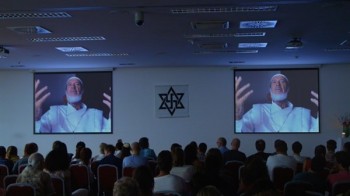
Is this a parody or pro-Raëlian propaganda? It never really quite makes up its mind, or maybe it is propaganda, but the whole thing plays as parody anyway. As apprentice film critic Lucille Manent says in her critique from the Bordeaux festival on the French-language festival review website ACCRÉDS (http://www.accreds.fr/), the filmmakers' neutral stance just doesn't work because of the aforementioned superficiality.
This film comes out in France 28 Jun. 2017. It's classified on AlloCiné as a mixture of documentary and "comédie dramatique."
Happiness Academy/Bonheur Academie, 75 mins., debuted at the Festival of Independent Film of Bordeaux 2016. It will have a French theatrical release 28 Jun. 2017. It was screened for this review as part of FSLC-MoMA's New Directors/New Films series (15-26 Mar. 2017).

ONLINE PHOTO OF A RAËLIAN CELEBRATION
Last edited by Chris Knipp; 03-02-2017 at 08:54 PM.
-
SEXY DUERGA (Sanal Kumar Sasidharan 2017)
SANAL KUMAR SASIDHARAN: SEXY DURGA (2017)
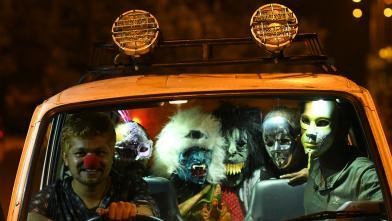
Long ride
This rough but visually lush and successfully disquieting film rubs some usually open-minded film critics the wrong way. Jay Weissberg of Variety its "Unremitting sadism," which he said "is the hallmark of this unpleasant impressionistic mood piece meant to draw attention to the degradation of women and man’s cruelty to man." Neil Young reviewed in in Hollywood Reporter with little more enthusiasm. He said "Sexy Durga is in the end just another exasperatingly elaborate illustration of Jean-Paul Sartre's timeless dictum, 'Hell is other people'." Maybe so. But Sexy Durga delivers a vivid and persistent and occasionally beautiful nightmare that will etch a little place on your brain. The use of improvisation without a script leads to a grating monotony that's all too real.
Sexy Durga starts out and is briefly bookended by an (actual, filmed) Indian folk ritual event where young men, observed by a big crowd (some filming with their smart phones) go into trances and are hoisted up above the people by hooks through the flesh of their backs and legs. It begins in daylight just as the sun's setting and goes on into the night. Later there are fires and running over hot coals.
While this is going on, a young couple hit the road hitchhiking to a railway station to go to Madras, so they say (we never quite know who they are or what their plan really is). They are picked up by two men in a van who become their psychological tormenters, mocking them and playing with them. All through the night they try to escape and get out briefly only to be picked up again. They cannot get away for long. Early on the van is stopped by cops - or are they? - who turn out to be more abusive to the abusers than the abusers are to the innocent couple.
It's a nightmare, a variation of one many of us have had where we keep trying to get somewhere but continually are frustrated. The tension is unrelenting and the couple is more and more helpless and frightened, especially the young woman (who can't speak the local language, adding to her helplessness). Toward the end, the van comes back once more and picks up the couple (who can't get a ride at this hour from anybody else: they keep getting in because it's even more frightening to be out on the dark road). This time, the van lights up inside and out like a flashing pinball machine while loud heavy metal music plays, and the men are wearing wild full-head masks. The eye candy of this sequence matches the exoticism and shock value of the men with hooks in their flesh. The critics call this flesh-piercing ritual masochism. But that's a simplification, because it's a traditional ritual. If they're in a trance, aren't they feeling no pain? The greater masochism may be the couple's reentering the van.
Sasidharan's cinematographer Prathap Joseph is skillful, seeming to fly through the air, riding on top of the van, staring down the luminous dividing line along the rural highway, flipping into the van from above. Some of the tricks he performs are mystifying. Those who describe this picture as directred in social or political terms toward mistreatment of women (or hooliganism or male sexual predators) doubtless are right, have a point but they risk missing its overriding nature as direct experience and transfixing dream.
This film debuted at Rotterdam, where it won the $43,000 Tiger Award. It was screened for this review as part of New Directors/New Films (FSLC-MoMA series, NYC, Feb. 2017).
Last edited by Chris Knipp; 03-02-2017 at 08:14 PM.
 Posting Permissions
Posting Permissions
- You may not post new threads
- You may not post replies
- You may not post attachments
- You may not edit your posts
-
Forum Rules





 Reply With Quote
Reply With Quote










Bookmarks